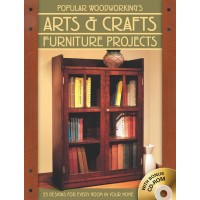We may receive a commission when you use our affiliate links. However, this does not impact our recommendations.

I’ve spent a good deal of energy investigating through-tenons. When I started collecting Arts & Crafts furniture in 1990, I quickly became attuned to spotting the joint in pieces for my collection.
Even better, I had a mentor with an incredible collection. Owen Riley was a photographer at the newspaper where I worked, and he had been collecting Arts & Crafts furniture for many years. His entire apartment was stuffed to the gills with the stuff. And he took great pains to teach me the difference between the makers , I can spot an L & J.G. tusk tenon over a Gustav Stickley tusk tenon from across a room.
And so I’ve always had a realistic view of how this joint appears in real-deal furniture that now costs five or six figures.
Here’s the real truth: The craftsmanship is all over the place. Take a look at the photo above. That’s a through-tenon on a signed Gustav Stickley slipper rocker from my collection. All the through-tenons on the piece look exactly like this. Clearly, they were made with some sort of boring tool, perhaps a drill press or perhaps some form of spindle machine. Heck you can still see some torn grain on the surface of the joint that indicates the rotation of the cutter.
No effort was made to square up the ends of the joint. No effort was made to round over the tenon to match the radiused mortise. There’s just a gap that’s plainly visible on the outside surfaces of the leg.
I always like to compare that joint to the through-tenons on my Charles Stickley arm chair. Charles was one of the “lesser” Stickley brothers, and the craftsmanship and style of his work is often derided by modern writers. The through-tenons on his chair are perfect, as good as any high-class modern work in a gallery.
There’s no consistency by maker. Roycroft through-tenons? Raggy. Limbert through-tenons? Not bad except for a couple overcuts , probably from a saw.
So what’s the pattern? Visibility. The more visible the joint, the more likely that the maker went to great lengths to make it tidy. That seems like it should be obvious, but that has not been my experience with modern work (especially my own).
My inclination is to make the suckers perfect. Why? Because I often have other woodworkers snooping around my house, pulling out my drawers, turning over my tables and the like.
So how do you make these joints spot-on? I’ve used several methods, which we’ll be exploring in the issue. For long and skinny joints, it’s hard to beat a highly-tuned hollow-chisel mortiser (though I’m going to try). For squarish joints, it’s hard to beat a template and a router.
And, in the end, it’s hard to beat wedging, which can expand a tenon into a loosely fit joint. Or, if you’ve had a bad day, putty and a dark dark stain…
Put your through-tenoning skills to the test with “Arts & Crafts Furniture Projects.”
Here are some supplies and tools we find essential in our everyday work around the shop. We may receive a commission from sales referred by our links; however, we have carefully selected these products for their usefulness and quality.










Your mention of "craftsmanship is all over the place" reminds me of when I went to the Peabody Essex Museum for the Samuel McIntire exhibit and reviewed the work of his two sons. Talk about a difference in quality!
It makes sense that the production woodworkers would have spent time where it matters. Since I’m not a professional woodworker, I’ll take my time on all my joinery — its the process not the product. If I had to make a living at it though, you better believe I’d be boring holes with my drill press in inconspicuous areas and focusing only on the visible joints!
Have you come across Paul Hasluck’s dovetail through tenon on his workbench design? I saw St. Roy build this on episode 2303 and always wanted to try this joint somewhere but haven’t yet. I found the workbench plans on a PDF on this page:
Looks like a sturdy way to join those bench legs.
Dave
Isn’t it just like us to romanticize about the past? We canonize our forebears forgetting that all they really wanted to do was turn out a product that lasts and get PAID! To me, it looks like they succeeded.
But it’s good to demystify things. There’s already too much mysticism about mundane things in this world. I say, DEBUNK and be exceedingly glad. Amen. Geez, that sounded preachy. Oh well, no vows of piety, chastity or secret handshakes here, let’s have a look-see and learn something. Bring it on!
BTW, I always cut mortises first and fit the tenons after regardless of the method. Whenever I’ve done the opposite I almost always have to conjure a fix and that’s where it gets mysterious. But putty and stain?! What is this, auto body repair?
always,
J.C.